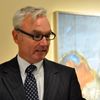As befits an art space that calls itself a "lab," the interior of the El Segundo Museum of Art is sparse. In the center of the space rests a chair and, piled with art books, a small table. The walls are lab white, the ceiling high. The room is as much lit by the sunlight that streams in through the front door as by the overhead bulbs.
"Lab" suggests clinical, sterile, perhaps; but the exhibition on display, Silence, is anything but. Unexpected curatorial choices make the artist list read more like an auction offering than the dramatis personae of a thematic show. The show convenes artists we know -- Andy Warhol, Rosa Bonheur, Kasimir Malevich, Richard Serra, Claude Monet, and Yves Klein, to name a few -- and artists not so familiar -- Lieven Hendriks, Wilhelm Maria Hubertus Leibl, and Ralph Fleck.
The work spans centuries. It isn't necessarily the artist's best work, nor is it necessarily even in the artist's signature style (an early Mondrian landscape? Do tell!). The Monets are Monets all right, even if but a fragment (two actually, identified as such).
Perhaps even more unexpected is the installation. There's no linear consistency where, for instance, each piece is consistently spaced, where each has a center point of sixty inches. It's more like you've entered the space in mid-installation. The work is grouped in twos, in threes, sometimes more. Irrespective of medium and date, the work is grouped by formal similarities -- colors, lines, and shapes. Abstract work abuts representational work and it feels like the most natural thing in the world.
Once you understand the logic of the installation, the intelligence behind the show becomes apparent. With keen insight, the exhibition suggests -- no, scratch that -- it proves how, at an elementary level of perception art, when it's shorn of -isms, historical context, and theory -- can be experienced as the sum of its formal elements. This perspective ensures the success of the groupings and allows us to realize that abstraction can converse with representation because formally they have so much in common. It's neither a connoisseur's approach, nor is it a scholar's approach. Instead it provides a way to make sense of the things that artists make without all the white noise (hence the perfectly chosen title, Silence, sweet, golden silence) that gloms onto the work once it leaves their studio. When you realize that, or are at least reminded, that there are similarities born of formal analysis, you can, at the very least, engage with a work of art on an intuitive level and only then, if so desired, determine its role in the sociopolitical arena. But the key is to feel the work before you think about it. The artist and their work demand as much.
The Silence of the title suggests that, below the white noise of individual works of art there is a level at which all art -- representational, abstract, two-dimensional, three-dimensional, irrespective of media -- can be experienced at an intuitive level. This explains the successful if surprising groupings of, say, Claude Monet, Ellsworth Kelly, and Michael Sistig or else Piet Mondrian and Amely Spoetz or Yves Klein, Richard Serra, Ralph Fleck, and Rebecca Lowry. These groupings remove the auras of textbook- and critic-applied artist reputations and force you to evaluate work on the way it works the formal elements, to find that, when you really get down to it, art is more similar than dissimilar. The effect is like the imaginary meeting E.M. Forster convened in "Aspects of the Novel" in which novelists, their particular life trajectories and social circumstances aside, would discuss their craft in terms of story, people, plot, fantasy, prophecy, pattern, and rhythm.
As the exhibition points out, if art really is indeed a lingua franca, then it's as much because of its shared vocabulary and syntax as much because of the common experiences it describes. Perhaps the best reward of Silence is how, in an age of skepticism, the exhibition encourages viewers to look at art, if not with a wary eye then at least with a suspicious one. That you look at it with an eye not jaundiced by received wisdom (or what passes for such) but with an empathy that begins with an engagement with the piece. The benefits are legion. You examine the work, not in terms of whether the artist is famous or her piece fetched a bundle at auction, but rather as the start of a conversation that is not partisan but, well, but human.
The exhibition runs until May 4. Museum hours are 10am - 5pm, Friday, Saturday, and Sunday. The Museum is located at 208 Main Street, El Segundo, California 90245. For more information call (424) 277-1021 or visit www.esmoa.org.

